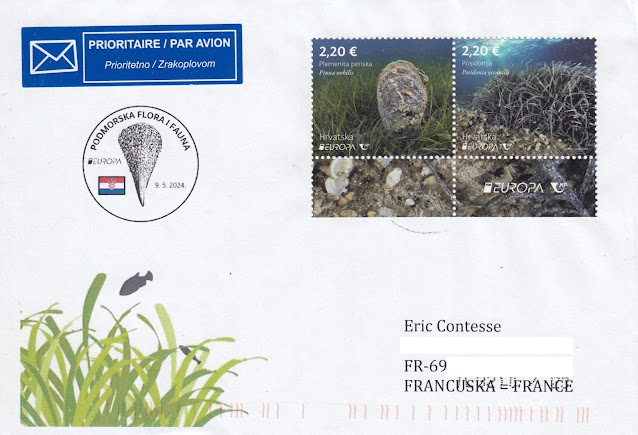Série EUROPA 2024 (Faune et flore subaquatiques) sur lettre de Croatie
Pour rappel, le thème choisi par l'association PostEurop pour les timbres EUROPA émis en 2024, la faune et flore subaquatiques ("Podmorska flora i fauna" en croate)
met en lumière la biodiversité des eaux européennes qui souffrent
de la surpêche, de la pollution et du changement climatique et qui
doivent être protégées pour les générations futures.
Le 9 mai 2024 (Journée de l'Europe), la poste croate a mis en circulation une série (2 timbres) illustrant ce thème, en particulier la posidonie de Méditerranée et la grande nacre.
Ces 2 timbres (2,20€, tirage : 40000 chacun), conçus par Alenka Lalić à partir de photographies sous-marines de Dalibor Andres, et imprimés dans une même feuille composée de 16 timbres (8 paires), ont été utilisés sur la lettre ci-dessous envoyée récemment depuis Rijeka (TAD illisible). Merci beaucoup Dragan !
As a reminder, the theme chosen by the PostEurop association for the EUROPA stamps issued in 2024, underwater fauna and flora
("Podmorska flora i fauna" in Croatian) highlights the biodiversity of
European waters which suffer from overfishing, pollution and climate
change and which must be protected for future generations.
On May 9, 2024 (Europe Day), the Croatian Post put into circulation a series (2 stamps) illustrating this theme, in particular the Mediterranean posidonia and the noble pen shell.
These two stamps (€2.20, print run: 40,000 each), designed by Alenka Lalić based on underwater photographs by Dalibor Andres, and printed in the same sheet made up of 16 stamps (8 pairs), have been used on the cover below sent recently from Rijeka (illegible postmark). Thank you very much Dragan!
La grande nacre (Pinna nobilis) est une espèce endémique de la Méditerranée, le plus grand bivalve de la mer Méditerranée et parmi les plus grands bivalves du monde. Il mesure généralement entre 30 et 50 cm mais peut atteindre une longueur allant jusqu'à 120 cm et vivre jusqu'à une cinquantaine d'années. Il vit dans les fonds sableux et les herbiers marins, jusqu'à une soixantaine de mètres de profondeur. Cette espèce est considérée comme "en danger critique" d'après l'UICN.
Mediterranean Posidonia (Posidonia oceanica) is a seagrass with dark green, meter-long leaves that grow in tufts from the tips of its intertwined branches. The branches grow only one centimeter per year and are often covered in sediment, sometimes in meters-long layers. Such branches began growing thousands of years ago, making Posidonia one of the longest-living organisms on Earth. This plant is responsible for clear waters, protecting beaches from wave erosion and serving as a refuge for many marine species.
The noble pen shell (Pinna nobilis) is an endemic species of the Mediterranean, the largest bivalve in the Mediterranean Sea and among the largest bivalves in the world. It usually grows between 30 and 50 cm but can reach lengths of up to 120 cm and live to be around fifty years old. It lives in sandy bottoms and seagrass meadows, from the surface up to about sixty meters in depth. This species is considered "critically endangered" according to the IUCN.

Aucun commentaire:
Enregistrer un commentaire